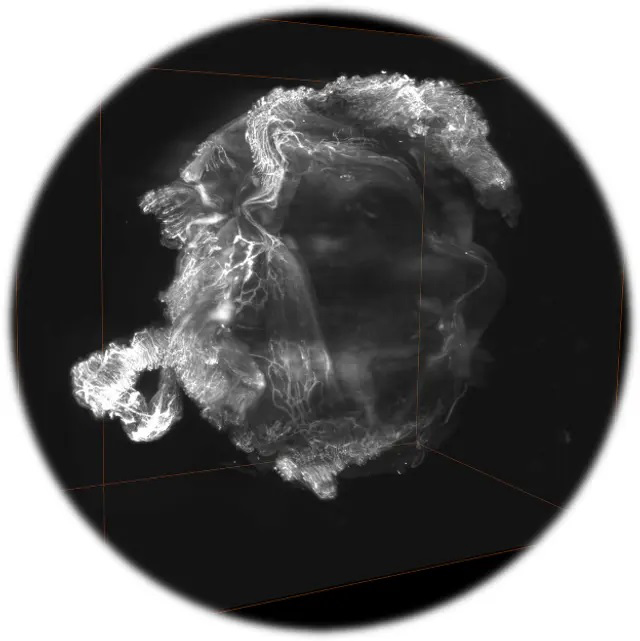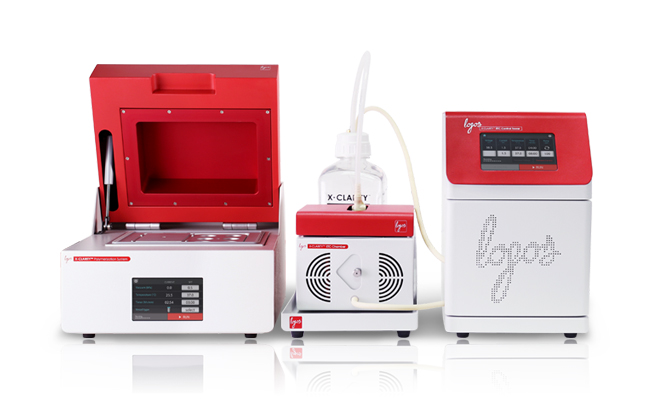Learn how one scientist is harnessing the latest imaging technology to advance his research and generate high-resolution images of neural tissue.
Research in the neurodegenerative sciences requires complex and advanced methods, especially when the focus is on something as sensitive as ocular tissues. Advanced techniques are required that can aid in the capture of fine details in neural tissues, and techniques that can accurately study changes within them. One such valuable tool is the and the X-Clarity™ Tissue Clearing Systems and Reagents by Logos Biosystems.
Dr. Sean James Miller, an associate research scientist in the Department of Ophthalmology and Visual Science at the Yale University School of Medicine, shares with us how he has utilized the X-Clarity™ System to unlock new heights in his research of the neurodegeneration of ocular tissues.
Miller’s primary responsibility is to spearhead and orchestrate various research projects focused on neurodegeneration and neuro-rejuvenation under the mentorship of Dr. Brian P. Hafler.
Miller’s primary objective is to unravel the obscure neuroanatomical signatures associated with neurodegenerative disorders, a pursuit that demands innovation and precision. His research endeavours are characterized by an interdisciplinary approach encompassing diverse fields such as neuroscience, bioengineering, and advanced imaging techniques.
A notable facet of Miller’s research toolkit is the utilization of cutting-edge technologies, among which the X-Clarity™ Tissue Clearing Systems feature prominently. By utilizing the power of the CLARITY method, Miller has achieved considerable advancements in visualizing and understanding the complex neural architecture underlying neurodegenerative conditions.

Dr. Sean James Miller, Associate Research Scientist at the Yale University School of Medicine
Visualization of intact tissues
In his latest research project, Miller focuses on revealing the pathophysiological mechanisms underlying neurodegenerative disorders, with a particular emphasis on early disease detection and therapeutic interventions. Central to this endeavour is the need for high-resolution imaging techniques capable of capturing the subtle structural changes occurring within neural tissues.
The adoption of the CLARITY method has been transformative in Miller’s research, as it enables the visualization of neuroanatomical structures with unprecedented clarity and detail. Through meticulous experimentation and optimization, Miller successfully removed the lipid composition of entire intact eye globes, including the attached optic nerve, achieving pseudo super-resolution imaging — a feat previously considered challenging with conventional methodologies. Miller emphasizes that this was, “achieved solely with the X-Clarity™ Tissue Clearing Systems and Reagents”.
The CLARITY method not only facilitated the visualization of intact tissues, but also expedited the data acquisition process, allowing Miller to generate robust datasets essential for deciphering the molecular and cellular alterations associated with neurodegeneration. Moreover, the method’s simplicity and reproducibility has minimized experimental variability, ensuring the reliability and consistency of results across experiments.
Empowering research excellence
The X-Clarity™ Tissue Clearing Systems and Reagents represent a significant leap forward in the field of tissue clearing, offering researchers a powerful toolkit to unravel the complexities of neurodegenerative diseases with unprecedented precision and efficiency. Developed by Logos Biosystems, the X-Clarity™ system, based on the CLARITY method, standardizes, simplifies, and accelerates each step of the tissue clearing process, revolutionizing the way researchers investigate neural tissues.
Central to the CLARITY method is its capacity to generate optically transparent tissue-hydrogel hybrids with preserved cytoarchitecture and fluorescence proteins. This enables researchers to visualize intact neural tissues with unparalleled clarity, facilitating the detection of subtle structural alterations associated with neurodegenerative diseases. Moreover, the CLARITY method streamlines the tissue clearing process, expediting data acquisition and analysis, and minimizing experimental variability.

Intact entire eye vasculature after tissue clearing with the X-CLARITYTM
The X-Clarity™ System comprises two key components: the X-Clarity™ Polymerization System and the X-Clarity™ Tissue Clearing System. The former simplifies tissue-hydrogel hybridization, enabling high-throughput sample processing with precise control over polymerization parameters. Meanwhile, the latter utilizes electrophoretic tissue clearing (ETC) technology to efficiently remove lipids while preserving sample integrity, offering intuitive touchscreen interfaces and active temperature control for optimal performance.
In addition to the X-Clarity™ Tissue Clearing Systems, Logos Biosystems offers the DeepLabel™ Antibody Staining Kit, tailored for use with clarified tissues. This innovative kit enhances antibody penetration and site-specific binding, facilitating comprehensive neuroanatomical investigations with superior signal-to-background ratios.
Implications of this key research
Miller’s research is making invaluable contributions to our understanding of ocular tissues and their potential implications for clinical practice in a number of significant ways, including:
· Early disease detection and intervention: By identifying neuroanatomical signatures associated with ocular diseases, Miller’s research enables early disease detection and intervention. Early detection is critical for initiating timely therapeutic interventions to prevent irreversible vision loss and preserve visual function.
· Personalized medicine approaches: Miller’s characterization of neuronal connectivity and neurodegenerative processes informs personalized medicine approaches tailored to individual patients. By understanding the unique molecular and cellular alterations driving disease progression in each patient, clinicians can develop targeted treatment strategies that optimize therapeutic outcomes.
· Development of novel therapeutic targets: Miller’s identification of novel therapeutic targets within ocular tissues opens avenues for the development of innovative treatment modalities. By targeting specific molecular pathways implicated in ocular diseases, researchers can design precision medicine interventions that address the underlying pathophysiology of these conditions, leading to improved clinical outcomes for patients.
· Advancement of vision-restoring therapies: Miller’s investigation of neuronal connectivity and neurodegenerative processes lays the groundwork for the development of vision-restoring therapies. By elucidating the neural circuits governing visual function and identifying strategies to mitigate neurodegeneration, researchers can explore innovative approaches to restore vision in individuals with vision impairment due to ocular diseases.
To discover quality tools and solutions that can enhance your confidence when carrying out sensitive neurological research, explore the X-CLARITY™ collection of systems and ready-to-use reagents developed by Logos Biosystems to make electrophoretic tissue clearing simple, fast, and efficient.

X-Clarity™ Tissue Clearing Systems and Reagents





